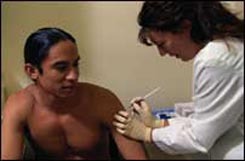How can I be exposed to Anthrax?
- Bacillus anthracis infection can occur in three forms:
- Cutaneous (skin)
- Inhalation
- Gastrointestinal
- Bacillus anthracis spores can live in soil for many years. Humans can become infected with anthrax by handling products from infected animals or by inhaling anthrax spores from contaminated animal products.
- Anthrax can also be spread by eating undercooked meat from infected animals. It is rare to find infected animals in the United States.
- Direct person-to-person spread of anthrax is extremely unlikely to occur. Communicability is not a concern in managing or visiting with patients with inhalational anthrax
What are the Symptoms of Anthrax?
Symptoms of disease vary depending on how the disease was contracted, but symptoms usually occur within 7 days.
- Cutaneous: Most (about 95 percent) anthrax infections occur when the bacterium enters a cut or abrasion on the skin, such as when handling contaminated wool, hides, leather, or hair products (especially goat hair) of infected animals. Skin infection begins as a raised itchy bump that resembles an insect bite but within 1-2 days develops into a vesicle and then a painless ulcer, usually 1-3 centimeters in diameter, with a characteristic black necrotic (dying) area in the center. Lymph glands in the adjacent area may swell. About 20 percent of untreated cases of cutaneous anthrax will result in death. Deaths are rare with appropriate antimicrobial therapy.
- Inhalation: Initial symptoms may resemble a common cold. After several days, the symptoms may progress to severe breathing problems and shock. Inhalation anthrax is often fatal.
- Intestinal: The intestinal disease form of anthrax may follow the consumption of contaminated meat and is characterized by an acute inflammation of the intestinal tract. Initial signs of nausea, loss of appetite, vomiting, and fever are followed by abdominal pain, vomiting of blood, and severe diarrhea. Intestinal anthrax results in death in 25 percent to 60 percent of cases. [Source: CDC Anthrax FAQ]
How is Anthrax Diagnosed and Treated?
Diagnosis: Anthrax is diagnosed by isolating Bacillus anthracis from the blood, skin lesions, or respiratory secretions or by measuring specific antibodies in the blood of persons with suspected cases.
Treatment: Doctors can prescribe effective antibiotics. Bacillus anthracis usually responds effectively to several antibiotics including penicillin, doxycycline, and fluoroquinolones (such as ciprofloxacin). To be effective, treatment should be initiated early. If left untreated, the disease can be fatal. Antibiotics
Further information on antimicrobial treatment of anthrax can be found on the following websites:
How Can I Prevent Anthrax Infection?
In countries where anthrax is common and vaccination levels of animal herds are low, humans should avoid contact with livestock and animal products and avoid eating meat that has not been properly slaughtered and cooked. Also, an anthrax vaccine has been licensed for use in humans. The vaccine is reported to be 93 percent effective in protecting against anthrax.

The anthrax vaccine is a cell-free filtrate vaccine, which means it contains no dead or live bacteria in the preparation. The final product contains no more than 2.4 milligrams of aluminum hydroxide as an additive. Anthrax vaccines intended for animals should not be used in humans. Vaccination
The Advisory Committee on Immunization Practices has recommend anthrax vaccination for the following groups:
- People who work directly with the organism in the laboratory,
- People who work with imported animal hides or furs in areas where standards are insufficient to prevent exposure to anthrax spores,
- People who handle potentially infected animal products in high-incidence areas (Incidence is low in the United States, but veterinarians who travel to work in other countries where incidence is higher should consider being vaccinated.), and
- Military personnel deployed to areas with high risk for exposure to the organism (as when it is used as a biological warfare weapon).
- First responders and workers involved in anthrax decontamination.
 Print
Print Email
Email









